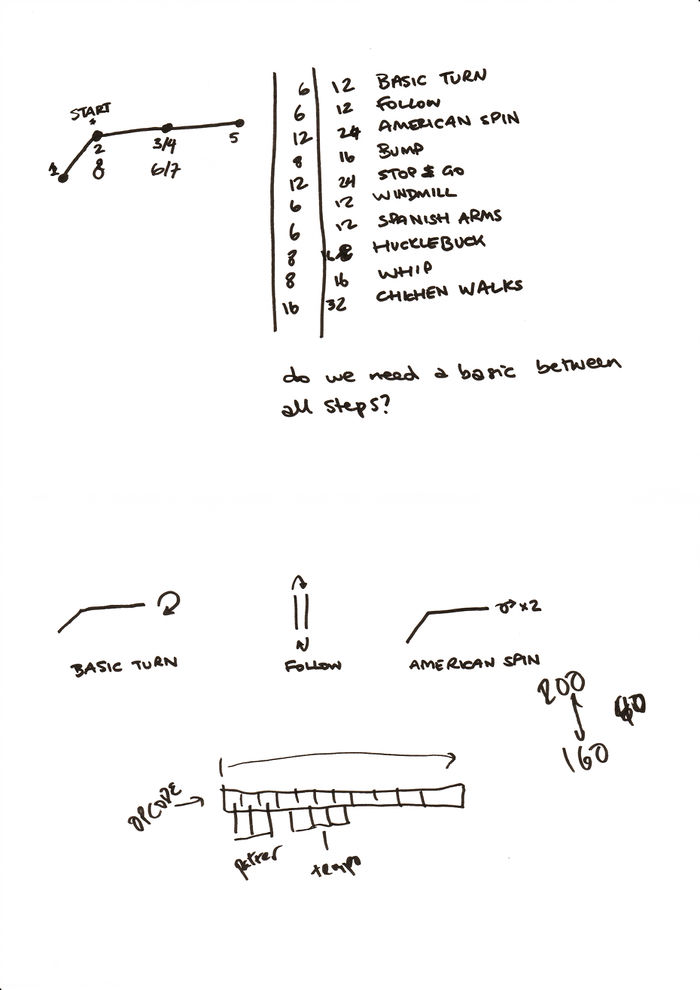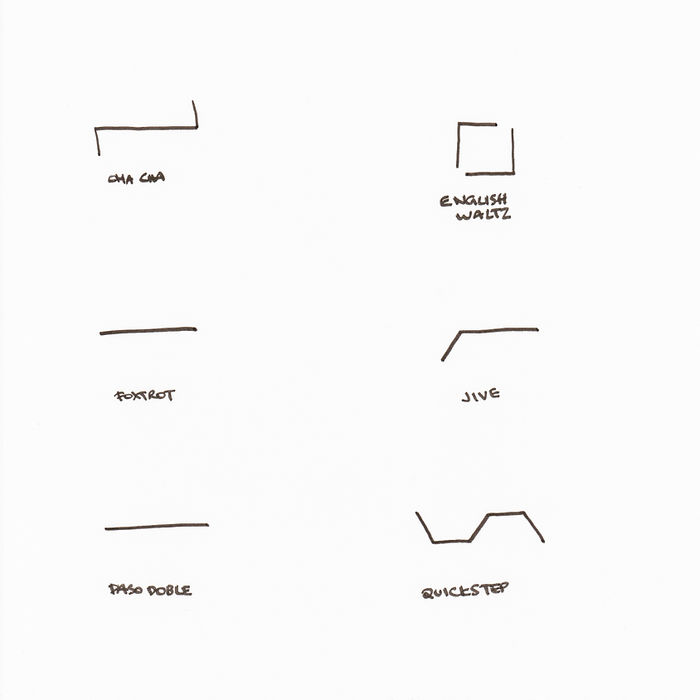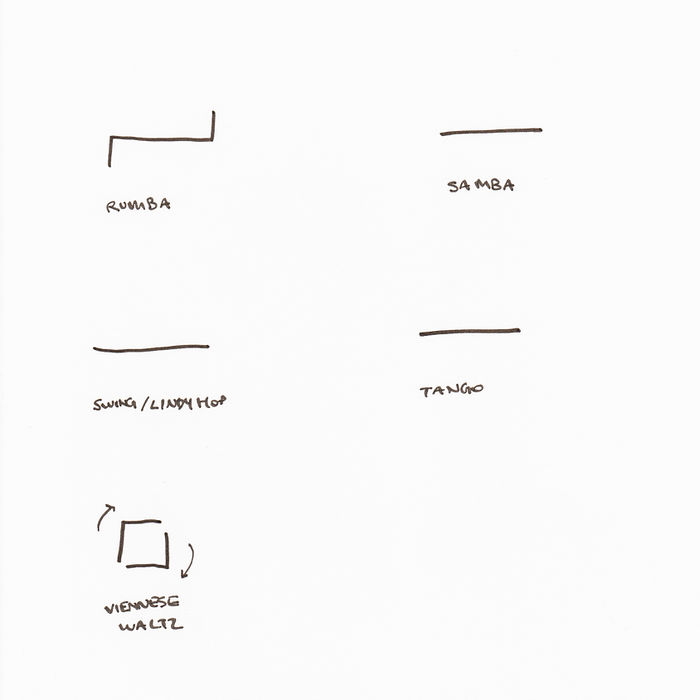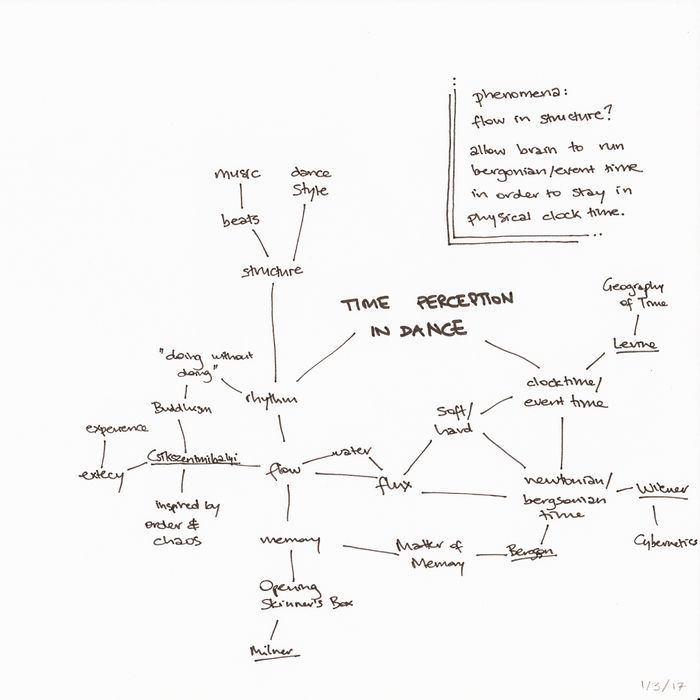Karina/special issue 02 individual research: Difference between revisions
No edit summary |
No edit summary |
||
| (47 intermediate revisions by the same user not shown) | |||
| Line 1: | Line 1: | ||
__NOTOC__ | __NOTOC__ | ||
===8 SEPT=== | |||
Netflix: [https://www.netflix.com/watch/80105356?trackId=13464114&tctx=8%2C0%2C882f0a4b-f7a0-4854-bf4a-ef9f3eef2abe-35409195 Alive and Kicking] | |||
<br> | |||
"My profession and my job is to teach people how to connect" (1:08) | |||
<br> | |||
<br> | |||
===11 AUG=== | |||
relevant search results for 'memory' on Whitney website | |||
<br> | |||
<br> | |||
* [http://press.whitney.org/file_columns/0004/1439/wilcox.pdf In the Air] by T.J. Wilcox | |||
"One by one, each projector cuts away from its role in producing the complete panorama and begins to present a short poetic narrative film inspired by a view from the studio’s window, weaving together images that evoke memory, transience, the passing of time, and the changing city." | |||
<br> | |||
<br> | |||
"Though this modernist dream never came to pass, Wilcox’s filmic collage reimagines the scenario, paying tribute to the New York City of forward-thinking dreamers. Interweaving our collective memory of one of the most iconic buildings in the world with its fantastic, unrealized past, Wilcox’s own daily view of it and his fantasy of what might have been, the film explores the overlap between historical, utopian, and personal narratives." | |||
<br> | |||
<br> | |||
"“I like my film and video work to appear as the visible record of my own journey through our saturated mediated age, highlighting those things that have held my attention and captured my imagination. Just as our perception of a present is a hybrid of personal memory, historical record, family lore, political, social, national, and artistic histories and mythologies, film and video provide the page upon which I make a collage of the ideas I hold most dear.” | |||
<br> | |||
<br> | |||
http://api.whitney.org/uploads/image/file/490432/xlarge_wilcox-web.jpg | |||
<br> | |||
<br> | |||
<br> | |||
* [http://whitney.org/WatchAndListen/385?series=2 My Turn] by Kerry Tribe | |||
"Filmmaker Kerry Tribe takes the elusive nature of memory as her subject matter in work that investigates subjectivity and representation. Through carefully crafted footage and interviews she reveals the power and influence of film and video in shaping beliefs and perception." | |||
<br> | |||
<br> | |||
[http://www.kerrytribe.com/media/2011/03/Culture24_Tribe.pdf more on Kerry Tribe] | |||
<br> | |||
<br> | |||
http://api.whitney.org/uploads/image/file/213295/large_kerry_tribe_at_table_2.jpg | |||
<br> | |||
<br> | |||
<br> | |||
* [http://whitney.org/Education/EducationBlog/CollageCourseAtSAGE Collage Course At SAGE] (Services and Advocacy for Gay, Lesbian, Bisexual & Transgender Elders) | |||
"Collage allows for the merging of found media—newsprint, magazine clippings, and photographs can be superimposed onto paper backgrounds or layered on top of one another, creating a whole from an accumulation of entirely independent parts. As in Bearden’s Eastern Barn, collage can tell personal or mythological stories, portray memories, and play with illusion. With these objectives in mind, the SAGE seniors began their own collage projects, investigating issues of memory and identity. They employed a variety of artistic strategies—some experimented with construction-paper forms, old photographs, magazine advertisements, ribbons, stickers, buttons, and other materials; others ventured out into the city to take photographs of themselves and their environments, using those images to connect their collages to the present moment." | |||
<br> | |||
<br> | |||
http://api.whitney.org/uploads/image/file/379030/xlarge_sage_senior_collage_detail.jpg | |||
<br> | |||
<br> | |||
<br> | |||
Anything worthy to see in the Guggenheim? | |||
<br> | |||
Found an anaglyph, but in Bilbao. What's the difference between an anaglyph and a stereograph? | |||
<br> | |||
<br> | |||
Guggenheim: [https://www.guggenheim-bilbao.eus/en/exhibitions/ken-jacobs-the-guests/ The Guests] by Ken Jacobs | |||
<br> | |||
<br> | |||
https://www.berlinale.de/media/filmstills/2014_1/forum_11/20148192_1_IMG_FIX_700x700.jpg | |||
<br> | |||
https://www.guggenheim-bilbao.eus/src/uploads/2016/11/Ken-Jacobs_The-Guests_Still.jpeg | |||
<br> | |||
<br> | |||
===10 AUG=== | |||
Whitney Museum NY: [http://whitney.org/Exhibitions/SarahMichelson Sarah Michelson's '4'], February 2014 | |||
<br> | |||
<br> | |||
http://api.whitney.org/uploads/image/file/515683/large_michelson.jpg | |||
<br> | |||
<br> | |||
"Choreographer Sarah Michelson premieres a new work on the Museum’s fourth floor, where she previously presented Devotion Study #1—The American Dancer, her Bucksbaum Award–winning piece from the 2012 Whitney Biennial. For this piece, the culmination of her Devotion series, Michelson continues to explore the dialogue between the form and history of dance through intense physicality, rigorous formal structures, and precise staging. The new work, 4, will be presented in an eight-performance engagement." | |||
<br> | |||
<br> | |||
continue reading [http://whitney.org/2012BucksbaumAwardToSarahMichelson Sarah Michelson Receives 2012 Bucksbaum Award] | |||
<br> | |||
<br> | |||
<br> | |||
Whitney Museum NY: [http://whitney.org/Education/EducationBlog/DoingTheFoxTrot Doing The Fox Trot] | |||
<br> | |||
<br> | |||
http://api.whitney.org/uploads/image/file/258112/xlarge_cc_whitney_174.jpg | |||
<br> | |||
<br> | |||
"A group of teachers trying out the fox trot may not be something you expect to see when you visit the Whitney but that was what happened on a Thursday morning in Off the Wall: Part 1—Thirty Performative Actions. A group of participants from Connecting Collections, a week-long Summer Institute for third to twelfth grade teachers, were following the steps illustrated in Andy Warhol’s Dance Diagram, 5 (Fox Trot: “The Right Turn – Man”), 1962. This work is one of seven paintings in Warhol's _Dance Diagram_ series from the early 1960s. For this series, Warhol reproduced "readymade" diagrams of ballroom dance steps onto canvas and displayed them on the floor." | |||
<br> | |||
<br> | |||
https://s-media-cache-ak0.pinimg.com/236x/14/55/85/14558528f56a288a147028db4a6ae782--dance-photos-dance-dance-dance.jpg | |||
<br> | |||
<br> | |||
read more about [http://collection.whitney.org/object/17218 Andy Warhol’s Dance Diagram, 5] | |||
<br> | |||
<br> | |||
"When the Museum educator showed this work to the teachers, they immediately knew it had something to do with dance. The footsteps, numbers, and arrows were familiar symbols that teachers have seen in dance instruction manuals. In fact, the Dance Diagram series are “based on images found in two dance books published by the Dance Guild in 1956: Lindy Made Easy (Charleston) and Fox Trot Made Easy” (Anonymous, 2003). After revealing this information to the teachers, the Museum educator encouraged the group to test out the steps and turns in the fox trot." | |||
<br> | |||
<br> | |||
https://pictures.abebooks.com/BOOKHAPPYBOOKS/md/md17440413536.jpg | |||
<br> | |||
<br> | |||
https://images-na.ssl-images-amazon.com/images/I/41tz-qvoCTL._SY223_BO1,204,203,200_.jpg | |||
<br> | |||
<br> | |||
https://i.pinimg.com/736x/45/c1/a1/45c1a1764ffd60deef622fcc64690628--swing-dancing-lindy-hop.jpg | |||
<br> | |||
https://i.pinimg.com/originals/a2/61/0e/a2610e66ccaac396e657e3113a0a976d.jpg | |||
<br> | |||
http://68.media.tumblr.com/ade6c10f61f0b1d0e00e08b903a2ef3e/tumblr_nrm6jkiRWu1qgwi7to2_1280.jpg | |||
<br> | |||
https://s-media-cache-ak0.pinimg.com/736x/e5/3f/68/e53f68a5109d5c2a19cd6a77ce680b84--swing-dancing-lindy-hop.jpg | |||
<br> | |||
<br> | |||
http://dujye7n3e5wjl.cloudfront.net/photographs/1080-tall/time-100-influential-photos-philippe-halsman-dali-atomicus-40.jpg | |||
<br> | |||
<br> | |||
more dance events at Whitney: | |||
* [http://whitney.org/Events/MoriahEvans Moriah Evans: Episodes and Fragments] | |||
* [http://whitney.org/Events/FallCourse2013BetweenBodiesAndObjects Between Bodies And Objects] | |||
** Jennie Goldstein - "Moving Bodies, Moving Things: Convergences of Art and Dance, 1960–1975" | |||
** Sylvia Palacios Whitman - "Passing Through" | |||
<br> | |||
<br> | |||
===8 AUGUST=== | |||
Vox: [https://www.youtube.com/watch?v=CrpkZkwTvu0 Why the ocean is getting louder] | |||
<br> | |||
<br> | |||
"Light does't penetrate very deep in water, so a lot of ocean life has evolved to use sound as its primary sense. Because water particles are more densely packed together than air, sound travels further and faster in water. That makes it an efficient medium for communication at any depth or time of day." - Christophe Haubursin | |||
<br> | |||
<br> | |||
"Lets say we have 440 (Hz), the middle key of your piano, if you looked at the wavelength of that sound in air, that 440 note would be a little less than a meter (wavelength = 78.41cm). In water it's more like several meters long." - John Hildebrand (professor at Scripps Institution of Oceanography | |||
<br> | |||
<br> | |||
"What that means is that sound travels about 4 times faster and further in water than in air" - Christophe Haubursin | |||
<br> | |||
<br> | |||
Twenty Thousand Hertz: [http://www.20k.org podcasts about sound] | |||
<br> | |||
<br> | |||
===23 MARCH=== | |||
glenn miller needs to be slowed down | |||
<br> | |||
https://archive.org/details/MedleyJustAGigoloIAintGotNobody | |||
<br> | |||
<br> | |||
[[File: floppy label screenshot.png | 400px]] | |||
<br> | |||
<br> | |||
Google Fonts | |||
<br> | |||
https://fonts.google.com/specimen/Poiret+One | |||
<br> | |||
<br> | |||
===22 MARCH=== | |||
[[File: button graphics.png | 300px]] | |||
<br> | |||
<br> | |||
https://www.thoughtco.com/jive-dance-basics-1007196 | |||
<br> | |||
<br> | |||
One, Two, Shu-ffle one, Shu-ffle two | |||
<br> | |||
One, Two, Tripple step, Tripple step | |||
<br> | |||
One, Two, Chassé front, Chassé back | |||
<br> | |||
Rock-step, Chassé front, Chassé back | |||
<br> | |||
<br> | |||
More available music | |||
<br> | |||
Clarence Smith (died 1929) - Pinetop's Boogie Woogie - 170 BPM | |||
<br> | |||
https://www.youtube.com/watch?v=ZfekNvYO1tI | |||
<br> | |||
<br> | |||
https://archive.org/details/78_boogie-woogie-stomp_albert-ammons-and-his-rhythm-kings-albert-ammons_gbia0001331b - 199 BPM too fast | |||
<br> | |||
https://archive.org/details/78_saxa-woogie_louis-jordan-and-his-tympany-five-louis-jordan_gbia0001289b - 167 BPM | |||
<br> | |||
https://archive.org/details/78_boogie-woogie_honey-hill-pinetop-smith_gbia0001120a - 156 BPM slower, but still fine | |||
<br> | |||
https://archive.org/details/78_pinetops-boogie-woogie_louis-jordan-and-his-tympany-five-pinetop-smith_gbia0001289a - 169 BPM | |||
<br> | |||
<br> | |||
===21 MARCH=== | |||
script in Sublime | |||
<br> | |||
<form action="cgi-bin/play.cgi" class="buttons"> | |||
<input type="submit" name="p" value="BasicTurn.mp3" style="background:url(images/choreology1-BasicTurn.svg) no-repeat;" /> | |||
<br> | |||
<br> | |||
[[File: choreology-BasicTurn_Basic Turn.png | 300px]] | |||
<br> | |||
<br> | |||
===20 MARCH=== | ===20 MARCH=== | ||
Compressing audio files in Audacity | Compressing audio files in Audacity | ||
| Line 7: | Line 192: | ||
# File | # File | ||
# Export as MP3 | # Export as MP3 | ||
<br> | |||
Jazz and Rock 'n' Roll artists who died before 1947 | |||
<br> | |||
http://thedeadrockstarsclub.com/1950.html | |||
<br> | |||
<br> | |||
Jelly Roll Morton - 1941 | |||
<br> | |||
https://www.youtube.com/watch?v=4n20U8hWHSE - too slow 105 BPM | |||
<br> | |||
https://www.youtube.com/watch?v=ujFWZrs6pow - too slow / or fast 120/240 BPM | |||
<br> | |||
<br> | |||
Charlie Christian - 1942 | |||
<br> | |||
https://www.youtube.com/watch?v=Ce9Jtl9D6FQ - too fast 219 BPM | |||
<br> | |||
https://www.youtube.com/watch?v=e93QIUPMKM4 (whole album, BPM varies) | |||
*01:40 217 BPM | |||
*'''09:20 185 PBM''' | |||
*11:50 190 BPM | |||
*'''23:10 171 BPM''' | |||
*29:30 200 BPM | |||
*'''38:20 188 BPM''' | |||
<br> | |||
Bennie Moten - 1935 | |||
<br> | |||
https://www.youtube.com/watch?v=hr42hm6GvkQ - too fast 198 BPM | |||
<br> | |||
https://www.youtube.com/watch?v=X9da72q3Has - too old style, from 1929 | |||
<br> | |||
<br> | |||
Milton Brown - 1936 | |||
<br> | |||
https://www.youtube.com/watch?v=W3NhWKDNMgM - 30s, yet too western | |||
<br> | |||
https://www.youtube.com/watch?v=qnjE5aB-cWQ - still 30s western | |||
<br> | |||
<br> | |||
John Mills Jr. - 1936 | |||
<br> | |||
part of Mills Brothers band, not copyright free | |||
<br> | |||
<br> | |||
Ken Johnson - 1941 | |||
<br> | |||
no info | |||
<br> | |||
<br> | |||
Don Murray - 1929 | |||
<br> | |||
no info | |||
<br> | |||
<br> | |||
Charley Patton - 1934 | |||
<br> | |||
https://www.youtube.com/watch?v=EyIquE0izAg - blues | |||
<br> | |||
<br> | |||
Bedrich "Fricek" Weiss - 1944 | |||
<br> | |||
no audio content found | |||
<br> | |||
https://books.google.nl/books?id=ioM3AgAAQBAJ&pg=PA200&lpg=PA200&dq=Bedrich+%22Fricek%22+Weiss&source=bl&ots=OrPeO7MvE2&sig=U7pjuSzeFxD24izxoR1qr5UfS9s&hl=en&sa=X&ved=0ahUKEwjmgtbkl-XSAhWGwxQKHYJcBr8Q6AEIGjAA#v=onepage&q=Bedrich%20%22Fricek%22%20Weiss&f=false | |||
<br> | |||
<br> | <br> | ||
===19 MARCH=== | ===19 MARCH=== | ||
| Line 123: | Line 373: | ||
<br> | <br> | ||
https://www.youtube.com/watch?v=_CI-0E_jses | https://www.youtube.com/watch?v=_CI-0E_jses | ||
<br> | |||
<br> | |||
Little Richard - still alive | |||
<br> | |||
Big Joe Turner - 1985 | |||
<br> | |||
Chuck Berry - 2017 | |||
<br> | |||
Mickey Hawks - 1989 | |||
<br> | |||
Johnny Burnette - 1964 | |||
<br> | <br> | ||
<br> | <br> | ||
| Line 595: | Line 856: | ||
===13 FEBRUARY=== | ===13 FEBRUARY=== | ||
http://www.luckytv.nl/gaga-dazzles/ | http://www.luckytv.nl/gaga-dazzles/ | ||
<br> | |||
<br> | |||
===2 FEBRUARY=== | |||
recording of jive session - only shuffling feet creating a rhythm | |||
<br> | <br> | ||
<br> | <br> | ||
Latest revision as of 16:49, 8 September 2017
8 SEPT
Netflix: Alive and Kicking
"My profession and my job is to teach people how to connect" (1:08)
11 AUG
relevant search results for 'memory' on Whitney website
- In the Air by T.J. Wilcox
"One by one, each projector cuts away from its role in producing the complete panorama and begins to present a short poetic narrative film inspired by a view from the studio’s window, weaving together images that evoke memory, transience, the passing of time, and the changing city."
"Though this modernist dream never came to pass, Wilcox’s filmic collage reimagines the scenario, paying tribute to the New York City of forward-thinking dreamers. Interweaving our collective memory of one of the most iconic buildings in the world with its fantastic, unrealized past, Wilcox’s own daily view of it and his fantasy of what might have been, the film explores the overlap between historical, utopian, and personal narratives."
"“I like my film and video work to appear as the visible record of my own journey through our saturated mediated age, highlighting those things that have held my attention and captured my imagination. Just as our perception of a present is a hybrid of personal memory, historical record, family lore, political, social, national, and artistic histories and mythologies, film and video provide the page upon which I make a collage of the ideas I hold most dear.”

- My Turn by Kerry Tribe
"Filmmaker Kerry Tribe takes the elusive nature of memory as her subject matter in work that investigates subjectivity and representation. Through carefully crafted footage and interviews she reveals the power and influence of film and video in shaping beliefs and perception."
more on Kerry Tribe

- Collage Course At SAGE (Services and Advocacy for Gay, Lesbian, Bisexual & Transgender Elders)
"Collage allows for the merging of found media—newsprint, magazine clippings, and photographs can be superimposed onto paper backgrounds or layered on top of one another, creating a whole from an accumulation of entirely independent parts. As in Bearden’s Eastern Barn, collage can tell personal or mythological stories, portray memories, and play with illusion. With these objectives in mind, the SAGE seniors began their own collage projects, investigating issues of memory and identity. They employed a variety of artistic strategies—some experimented with construction-paper forms, old photographs, magazine advertisements, ribbons, stickers, buttons, and other materials; others ventured out into the city to take photographs of themselves and their environments, using those images to connect their collages to the present moment."

Anything worthy to see in the Guggenheim?
Found an anaglyph, but in Bilbao. What's the difference between an anaglyph and a stereograph?
Guggenheim: The Guests by Ken Jacobs


10 AUG
Whitney Museum NY: Sarah Michelson's '4', February 2014

"Choreographer Sarah Michelson premieres a new work on the Museum’s fourth floor, where she previously presented Devotion Study #1—The American Dancer, her Bucksbaum Award–winning piece from the 2012 Whitney Biennial. For this piece, the culmination of her Devotion series, Michelson continues to explore the dialogue between the form and history of dance through intense physicality, rigorous formal structures, and precise staging. The new work, 4, will be presented in an eight-performance engagement."
continue reading Sarah Michelson Receives 2012 Bucksbaum Award
Whitney Museum NY: Doing The Fox Trot

"A group of teachers trying out the fox trot may not be something you expect to see when you visit the Whitney but that was what happened on a Thursday morning in Off the Wall: Part 1—Thirty Performative Actions. A group of participants from Connecting Collections, a week-long Summer Institute for third to twelfth grade teachers, were following the steps illustrated in Andy Warhol’s Dance Diagram, 5 (Fox Trot: “The Right Turn – Man”), 1962. This work is one of seven paintings in Warhol's _Dance Diagram_ series from the early 1960s. For this series, Warhol reproduced "readymade" diagrams of ballroom dance steps onto canvas and displayed them on the floor."

read more about Andy Warhol’s Dance Diagram, 5
"When the Museum educator showed this work to the teachers, they immediately knew it had something to do with dance. The footsteps, numbers, and arrows were familiar symbols that teachers have seen in dance instruction manuals. In fact, the Dance Diagram series are “based on images found in two dance books published by the Dance Guild in 1956: Lindy Made Easy (Charleston) and Fox Trot Made Easy” (Anonymous, 2003). After revealing this information to the teachers, the Museum educator encouraged the group to test out the steps and turns in the fox trot."







more dance events at Whitney:
- Moriah Evans: Episodes and Fragments
- Between Bodies And Objects
- Jennie Goldstein - "Moving Bodies, Moving Things: Convergences of Art and Dance, 1960–1975"
- Sylvia Palacios Whitman - "Passing Through"
8 AUGUST
Vox: Why the ocean is getting louder
"Light does't penetrate very deep in water, so a lot of ocean life has evolved to use sound as its primary sense. Because water particles are more densely packed together than air, sound travels further and faster in water. That makes it an efficient medium for communication at any depth or time of day." - Christophe Haubursin
"Lets say we have 440 (Hz), the middle key of your piano, if you looked at the wavelength of that sound in air, that 440 note would be a little less than a meter (wavelength = 78.41cm). In water it's more like several meters long." - John Hildebrand (professor at Scripps Institution of Oceanography
"What that means is that sound travels about 4 times faster and further in water than in air" - Christophe Haubursin
Twenty Thousand Hertz: podcasts about sound
23 MARCH
glenn miller needs to be slowed down
https://archive.org/details/MedleyJustAGigoloIAintGotNobody
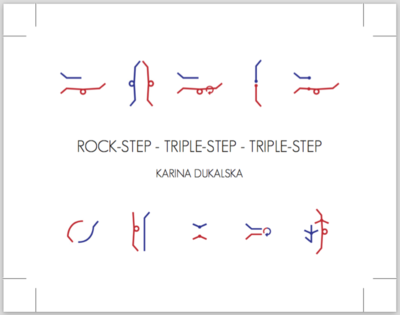
Google Fonts
https://fonts.google.com/specimen/Poiret+One
22 MARCH
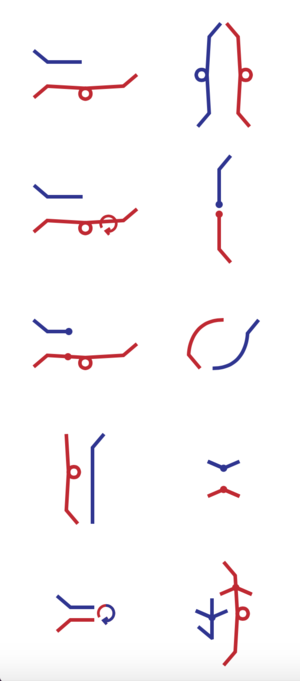
https://www.thoughtco.com/jive-dance-basics-1007196
One, Two, Shu-ffle one, Shu-ffle two
One, Two, Tripple step, Tripple step
One, Two, Chassé front, Chassé back
Rock-step, Chassé front, Chassé back
More available music
Clarence Smith (died 1929) - Pinetop's Boogie Woogie - 170 BPM
https://www.youtube.com/watch?v=ZfekNvYO1tI
https://archive.org/details/78_boogie-woogie-stomp_albert-ammons-and-his-rhythm-kings-albert-ammons_gbia0001331b - 199 BPM too fast
https://archive.org/details/78_saxa-woogie_louis-jordan-and-his-tympany-five-louis-jordan_gbia0001289b - 167 BPM
https://archive.org/details/78_boogie-woogie_honey-hill-pinetop-smith_gbia0001120a - 156 BPM slower, but still fine
https://archive.org/details/78_pinetops-boogie-woogie_louis-jordan-and-his-tympany-five-pinetop-smith_gbia0001289a - 169 BPM
21 MARCH
script in Sublime
<form action="cgi-bin/play.cgi" class="buttons">
<input type="submit" name="p" value="BasicTurn.mp3" style="background:url(images/choreology1-BasicTurn.svg) no-repeat;" />

20 MARCH
Compressing audio files in Audacity
- Edit and Open
- Project Rate
- Split Stereo Track > Mono (optional, if stereo isn’t essential - reduces file even more)
- File
- Export as MP3
Jazz and Rock 'n' Roll artists who died before 1947
http://thedeadrockstarsclub.com/1950.html
Jelly Roll Morton - 1941
https://www.youtube.com/watch?v=4n20U8hWHSE - too slow 105 BPM
https://www.youtube.com/watch?v=ujFWZrs6pow - too slow / or fast 120/240 BPM
Charlie Christian - 1942
https://www.youtube.com/watch?v=Ce9Jtl9D6FQ - too fast 219 BPM
https://www.youtube.com/watch?v=e93QIUPMKM4 (whole album, BPM varies)
- 01:40 217 BPM
- 09:20 185 PBM
- 11:50 190 BPM
- 23:10 171 BPM
- 29:30 200 BPM
- 38:20 188 BPM
Bennie Moten - 1935
https://www.youtube.com/watch?v=hr42hm6GvkQ - too fast 198 BPM
https://www.youtube.com/watch?v=X9da72q3Has - too old style, from 1929
Milton Brown - 1936
https://www.youtube.com/watch?v=W3NhWKDNMgM - 30s, yet too western
https://www.youtube.com/watch?v=qnjE5aB-cWQ - still 30s western
John Mills Jr. - 1936
part of Mills Brothers band, not copyright free
Ken Johnson - 1941
no info
Don Murray - 1929
no info
Charley Patton - 1934
https://www.youtube.com/watch?v=EyIquE0izAg - blues
Bedrich "Fricek" Weiss - 1944
no audio content found
https://books.google.nl/books?id=ioM3AgAAQBAJ&pg=PA200&lpg=PA200&dq=Bedrich+%22Fricek%22+Weiss&source=bl&ots=OrPeO7MvE2&sig=U7pjuSzeFxD24izxoR1qr5UfS9s&hl=en&sa=X&ved=0ahUKEwjmgtbkl-XSAhWGwxQKHYJcBr8Q6AEIGjAA#v=onepage&q=Bedrich%20%22Fricek%22%20Weiss&f=false
19 MARCH
Text to Speech
http://www.fromtexttospeech.com
- Language: US English
- Voice: George
- Speed: Medium / Fast
All 10 FAST recorded instructions = 84KB
All 10 MEDIUM recorded instructions = 88KB
18 MARCH
Swing dance evolution
https://en.wikipedia.org/wiki/Swing_(dance)
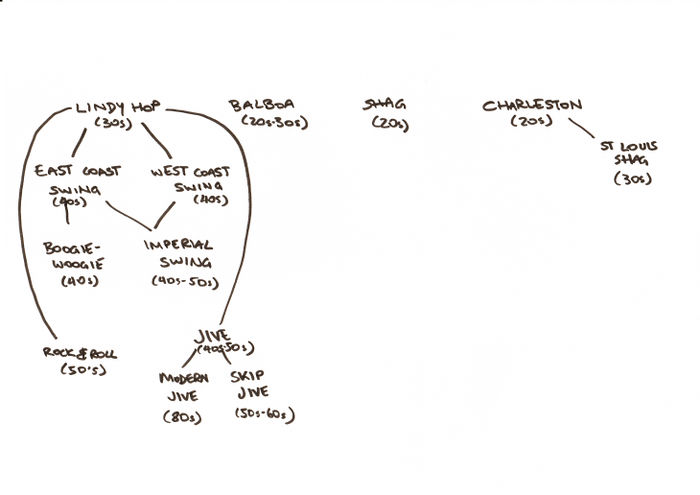
Music for Jive
Mix of jazz, swing and rock 'n' roll
approximately 160 - 180 BPM
Playlists
Jive by Karina Dukalska
https://embed.spotify.com/?uri=spotify%3Auser%3A1128072303%3Aplaylist%3A4fN3xPkuqmOjFaKSiMSkEd
40s 50s Rock 'n' Roll by David Patiño
https://embed.spotify.com/?uri=spotify%3Auser%3A12157046444%3Aplaylist%3A2XDA2aWNqzYjqas7hQhTmP
Jive by fernando.gy97
https://embed.spotify.com/?uri=spotify%3Auser%3Afernando.gy97%3Aplaylist%3A7Jnq7vkzbgHXxzeD49IOTe
SWING - BIG BAND by Pol Cayuela
https://embed.spotify.com/?uri=spotify%3Auser%3Akenshiro_o%3Aplaylist%3A1A51AEZEh5Gm8KVPLqhyzK
3 contacts give only 7 options
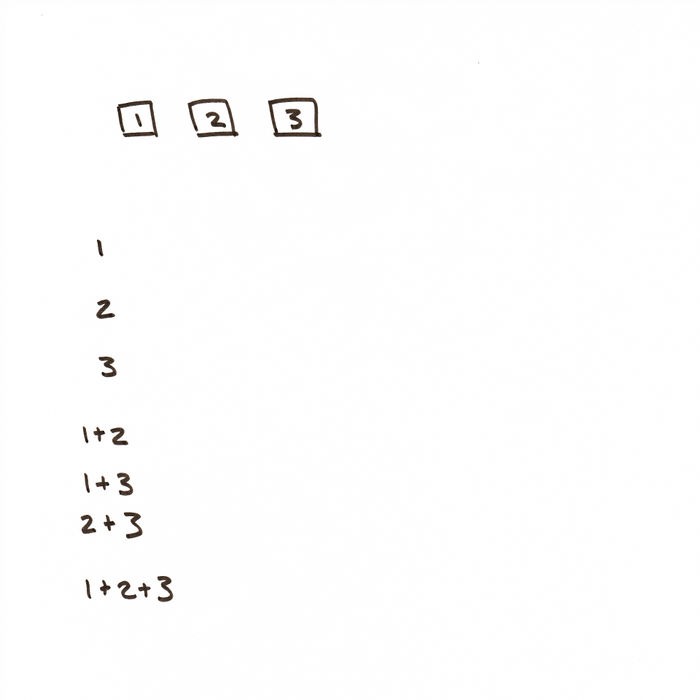
6 contacts give more than 12 options. Contact 1 and 2 would have a different function, so they should be kept separate not to confuse the users.
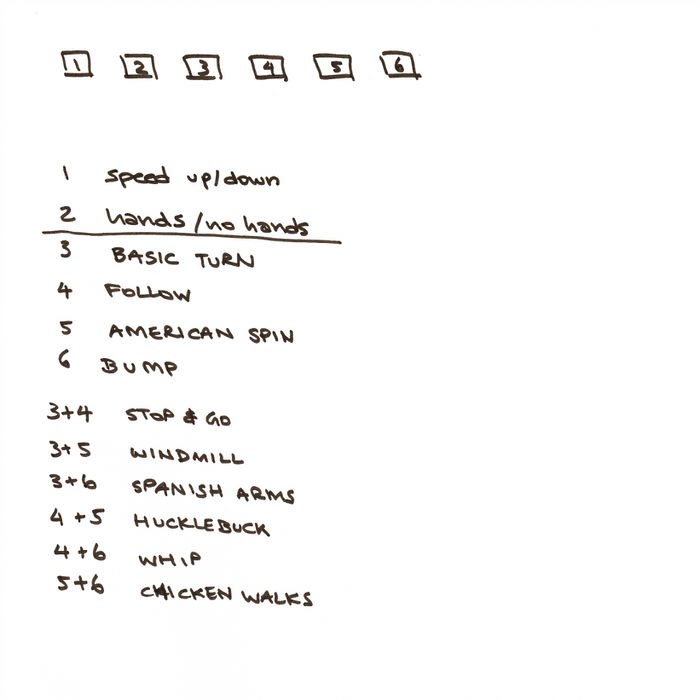
16 MARCH
Inputs
- tempo / speed
- steps 1-10
- hands / no hands
Anna tested the instructions on us. She made her own random order (first by listing numbers, then correlating them to step names). Very quickly she got the hang of it and did very well in giving the next instruction in time, without being too early. With time, we experimented with her breaking our flow on purpose: instructions at bad timing; difficult combinations of steps; dancing with no hands for a long time. How will my partner and I communicate to continue our flow?
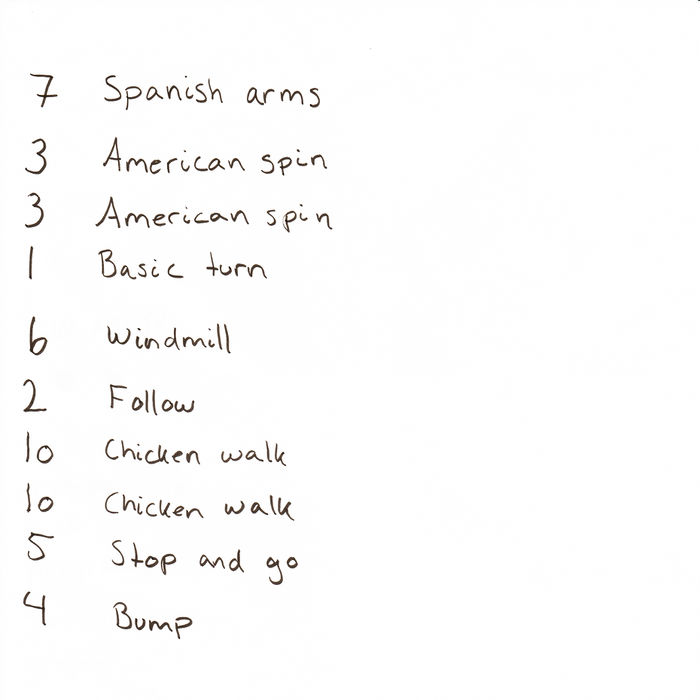
Points that came out of practice session
- should we show the full dance in order? - yes.
- is it clear that double steps (American spin, Bump, Stop & Go) are meant to be double? - no.
- do we stick to strict 2 axes - vertical and horizontal direction? - no.
- could we dance to midi? - no. the feel/vibe/style changes completely.
- what will we dance to?
- how will we communicate to stop because instructions were given too early? - squeeze hand of partner
- is dancing with/without hands possible? - yes.
Performance details
- dance double steps (American spin, Bump, Stop & Go) only once
- dance full routine in 'correct' order once at the start
- if an instruction is given too early, current step will be finished, but new one will not begin
- standard (1-2 steps backwards) at the start of every move
- 1 or 2 royalty free songs on floppy
- for performance choose other music, songs that people will recognise
- dress up a little: flats or heels?
Royalty Free Music
http://freemusicarchive.org/genre/Jazz/?sort=track_date_published&d=1&page=1
15 MARCH
Looking for anyone who passed away earlier than February 1947
Dean Martin - 1995
Frank Sinatra - 1998
Ray Charles - 2004
Louis Armstrong - 1971
Billie Holiday - 1959
Ella Fitzgerald - 1996
Nina Simone - 2003
Glenn Miller - 1944
https://www.youtube.com/watch?v=_CI-0E_jses
Little Richard - still alive
Big Joe Turner - 1985
Chuck Berry - 2017
Mickey Hawks - 1989
Johnny Burnette - 1964
13 MARCH
new changes
- no screen - find new way to view queued instructions and choreology
- no direct usb connection to use keyboard. need dongle
- Replacing keyboard with cobbler connected to a breadboard
- Design and write out what is the function/outcome of each of the 6 inputs
- Find royalty free music - possibly midi?
Hall & Oates midi
http://www.singingstation.com/midi-files/hall-oates/you-make-my-dreams
Finally found it - was trying to find it in my archive for weeks. ‘DIMI’ & Helsinki Electronic Music Studio, Erkki Kurenniemi
https://120years.net/dimi-helsinki-electronic-music-studioerkki-kurenniemifinland1961-2/
10 MARCH
What still needs to be done
- simple website with documentation and extra content (movies, imagery)
- choreology for each of 9 steps
- see how long each step takes (8-16 beats)
- converting project to code
Doable steps:
- List all moves from a dance (in official terminology) and give them a correlating number.
- Create code that interprets numbers into terminology
- Create terminology / instructions as markup text
- Convert markup text into audio
Further steps:
Commands will be said only every 8 beats in the song.
- Is there a way to queue commands / terminology?
- How to have the spoken instructions told through the speakers at the right moment?
Music will take up too much space on the floppy, so that might need to be external.
- How to sync the speed of the song to the spoken instructions intervals? BPM calculator (different songs = different BPM)
- How to communicate BPM to queue tempo?
- Can the Pi read any language?
- Does it have an operating system (which one), or is it just a shell?
- Are there any limitations to any language I could be using?
- Is making a web interface using Java Script and then connecting the Pi to a screen possible?
printing the choreology?
Music alternatives
Swing / Jive midi
https://www.youtube.com/watch?v=v0ZOo2DMack
https://www.youtube.com/watch?v=E6XACt1s-z0
Other dances
Foxtrot https://www.youtube.com/watch?v=vW3w8kV-Xmo
Quickstep https://www.youtube.com/watch?v=stsBqdo9Svc
Samba https://www.youtube.com/watch?v=sY20ixaf2PM
Waltz https://www.youtube.com/watch?v=vCKU5gwXQRo
7 MARCH
Time Perception in Dance - essay for Methods
https://pzwiki.wdka.nl/mediadesign/Karina/time_perception_in_dance
3 MARCH
Additional task for experiment
- List a few songs that (personally) suit each given dance style
- Find average BPM (beat per minute) for each song
- Research what the average recommended BPM is per style
- Compare my BPM range with recommended BPM range
BPM ranges were compared with the following sources:
- Sheris Musings (Leblanc, 2011)
- Beats Per Minute Online (Beatsperminuteonline.com. n.d.)
- Hollywood Ballroom DC (Gross, 2012)
| CHA CHA | ||
|---|---|---|
| Song | Artist | BPM |
| Cake by the Ocean | DNCE | 119 |
| Mercy | Duffy | 130 |
| El Chacal | Jose Conde | 118 |
| Mambo No. 5 | Lou Bega | 174 |
| Smooth | Santana | 116 |
| My range | 116 - 130 | |
| Range: Sheri Leblanc Musings | approximately 112 - 128 | |
| Range: beatsperminuteonline.com | 120 - 128 | |
| Range: Hollywood Ballroom DC | 112 - 128 | |
| ENGLISH WALTZ | ||
|---|---|---|
| Song | Artist | BPM |
| Moon River | Audrey Hepburn | 92 |
| La Javanaise | Madeleine Peyroux | 108 |
| Come Away With Me | Norah Jones | 81 |
| Nocturne | Secret Garden | 80 |
| My range | 80 - 108 | |
| Range: Sheri Leblanc Musings | approximately 90 - 100 | |
| Range: beatsperminuteonline.com | 84 - 90 | |
| Range: Hollywood Ballroom DC | 84 - 93 | |
| FOXTROT | ||
|---|---|---|
| Song | Artist | BPM |
| Ain't That a Kick in the Head | Dean Martin | 132 |
| James Bond Theme | 116 | |
| Dance Me to the End of Love | Madeleine Peyroux | 137 |
| Fever | Michael Buble | 128 |
| Orange Colored Sky | Nat King Cole | 130 |
| My range | 116 - 137 | |
| Range: Sheri Leblanc Musings | approximately 120 | |
| Range: beatsperminuteonline.com | 112 - 120 | |
| Range: Hollywood Ballroom DC | 112 - 120 | |
| JIVE | ||
|---|---|---|
| Song | Artist | BPM |
| You Make My Dreams | Hall & Oates | 167 |
| Doin' It Right | Power Blues | 165 |
| My range | 165 - 167 | |
| Range: Sheri Leblanc Musings | approximately 180 | |
| Range: beatsperminuteonline.com | 168 - 184 | |
| Range: Hollywood Ballroom DC | 152 - 176 | |
| PASO DOBLE | ||
|---|---|---|
| Song | Artist | BPM |
| Cielo Andaluz | ? | 112 |
| El Gato Montes | ? | 116 |
| El toro de tu sueno | ? | 120 |
| My range | 112 - 120 | |
| Range: Sheri Leblanc Musings | - | |
| Range: beatsperminuteonline.com | 120 - 124 | |
| Range: Hollywood Ballroom DC | 112 - 124 | |
| QUICKSTEP | ||
|---|---|---|
| Song | Artist | BPM |
| Beatophone | Caravan Palace | 252 |
| Dramophone | Caravan Palace | 252 |
| Tangled Up | Caro Emerald | 202 |
| It Don't Mean A Thing | Geoff Love Orchestra | 199 |
| My range | 199 - 252 | |
| Range: Sheri Leblanc Musings | approximately 200 | |
| Range: beatsperminuteonline.com | 200 - 208 | |
| Range: Hollywood Ballroom DC | 200 - 208 | |
| RUMBA | ||
|---|---|---|
| Song | Artist | BPM |
| Chan Chan | Buena Vista Social Club | 81 |
| Sway | Dean Martin | 120 |
| Girl From Ipanema | Joao Gilberto | 128 |
| Those Sweet Words | Norah Jones | 103 |
| My range | 81 - 128 | |
| Range: Sheri Leblanc Musings | - | |
| Range: beatsperminuteonline.com | 100 - 108 | |
| Range: Hollywood Ballroom DC | 96 - 112 | |
| SAMBA | ||
|---|---|---|
| Song | Artist | BPM |
| Bailar | Deorro ft. Elvis Crespo | 128 |
| Suavemente | Elvis Crespo | 124 |
| Lambada 3000 | Kaoma, Gregor Salto | 127 |
| Tu Picadura | Dancelife | 102 |
| Dejarè La Puerta Abierta | Danilo | 100 |
| My range | 100 - 128 | |
| Range: Sheri Leblanc Musings | - | |
| Range: beatsperminuteonline.com | 96 - 104 | |
| Range: Hollywood Ballroom DC | 96 - 104 | |
| SWING / LINDY HOP | ||
|---|---|---|
| Song | Artist | BPM |
| My Baby Just Cares for Me | Nina Simone | 118 |
| Cheek to Cheek | Billie Holiday | 145 |
| Volare | Dean Martin | 130 |
| Ochi Chornya | Wingy Manone | 165 |
| Just a Gigolo | Louis Prima | 124 |
| E-Flat Boogie | Buster Smith | 163 |
| My range | 118 - 165 | |
| Range: Sheri Leblanc Musings | approximately 140 | |
| Range: beatsperminuteonline.com | 105 - 190 | |
| Range: Hollywood Ballroom DC | 136 - 144 | |
| TANGO | ||
|---|---|---|
| Song | Artist | BPM |
| La Cumparsita | Carlos Di Sarli | 116 |
| Santa Maria | Gotan Project | 118 |
| Una Música Brutal | Gotan Project | 107 |
| El Tango De Roxanne | Jose Feliciano | 108 |
| My range | 107 - 118 | |
| Range: Sheri Leblanc Musings | approximately 120 | |
| Range: beatsperminuteonline.com | 80 - 160 | |
| Range: Hollywood Ballroom DC | 120 - 132 | |
| VIENNESE WALTZ | ||
|---|---|---|
| Song | Artist | BPM |
| Waltz No. 2 | Dmitri Shostakovich | 187 |
| 3 Valses, Op. 64 No.2 In C Sharp Minor | Frederic Chopin | 230 |
| Love Ain't Gonna Let You Down | Jamie Cullum | 130 |
| The Blue Danube | Johann Strauss | 183 |
| Nutcracker | Tchaikovsky | 208 |
| Sleeping Beauty | Tchaikovsky | 190 |
| La Valse d'Amelie | Yann Tiersen | 192 |
| My range | 130 - 230 | |
| Range: Sheri Leblanc Musings | approximately 190 | |
| Range: beatsperminuteonline.com | 174 - 180 | |
| Range: Hollywood Ballroom DC | 150 - 180 | |
2 MARCH
Experiment
- List all dance styles
- Illustrate movement using choreology
- Explain rhythm in words
- Illustrate rhythm using choreology
- Analyse differences between dances
1 MARCH
22 FEBRUARY
https://pzwiki.wdka.nl/mediadesign/Joana%27s_Thesis_Outline
21 FEBRUARY
Choreomusicology (list of artists that create choreologies)
https://en.wikipedia.org/wiki/Choreomusicology
Merce Cunningham - created choreology (worked with Cage and Tudor)
https://en.wikipedia.org/wiki/Merce_Cunningham
Feuillet notations
https://en.wikipedia.org/wiki/Beauchamp-Feuillet_notation (17-18th century)
http://www.baroquedance.com/research/dancenotation.htm
http://www.contemporary-dance.org/how-to-write-feuillet-notation.html
George Balanchine (ballet choreographer)
https://en.wikipedia.org/wiki/George_Balanchine
Rudolf Benesh - mathematician created movement notation
https://en.wikipedia.org/wiki/Rudolf_Benesh
https://en.wikipedia.org/wiki/Benesh_Movement_Notation
Igor Stravinsky notation
https://en.wikipedia.org/wiki/Igor_Stravinsky
Lebanotation 1920s, still used today
https://en.wikipedia.org/wiki/Labanotation
Still used today because it takes many factors into consideration
- Direction and level of the movement
- Part of the body doing the movement
- Duration of the movement
- Dynamic quality of the movement
Anne Teresa de Keersmaeker - dancer that draws dance with footprints
https://www.moma.org/calendar/performance/1580
https://www.youtube.com/watch?v=E1OHl8_MPEg (Performance 13)
20 FEBRUARY
Experiment: Learning Swing Basics
How similar is it to what I already know from ballroom?
How similar is it to a Jive?
How long will I need to learn the first level?
Will I manage to remember the terminology?
Will I remember the dance once I get home?
Will I be able to fall into a flow? How long will it take?
What will be the experience / connection with a new dance parter?
Is Swing just as addictive as they say?
Task:
- Find new dance style to try
- Organise private classes with an instructor
- Note down questions that arose before the class
- Go to dance classes unprepared (didn’t look up steps, rhythm or what to wear)
- Note down experience once the class is done
13 FEBRUARY
http://www.luckytv.nl/gaga-dazzles/
2 FEBRUARY
recording of jive session - only shuffling feet creating a rhythm
1 FEBRUARY
Experiment
What would happen if we broke down the structure / order of the dance?
How will that effect the flow?
How will our memory work?
Will we be more conscious of what we are doing?
Will I need to let my parter lead me more? More trust if less anticipation?
Task:
- Select 6 steps from a Jive
- List them in order using names / terminology and number them 1-6
- Roll a die and note down the outcome
- Repeat step 3 a couple of times
- Rewrite steps in new order using step names / terminology
- Dance the re-constructed Jive
- Describe experience (use questions from above)
Jive first 6 steps
- Basic Turn
- Follow the Leader
- American Swing
- Bump
- The ‘1-2’
- Windmill + Spanish Arms
New order
3 - 1 - 6 - 2 - 4 - 2
American Swing
Basic Turn
Windmill + Spanish Arms
Follow the Leader
Bump
Follow the Leader
28 JANUARY
Some screenshots of my 'sketchbook'
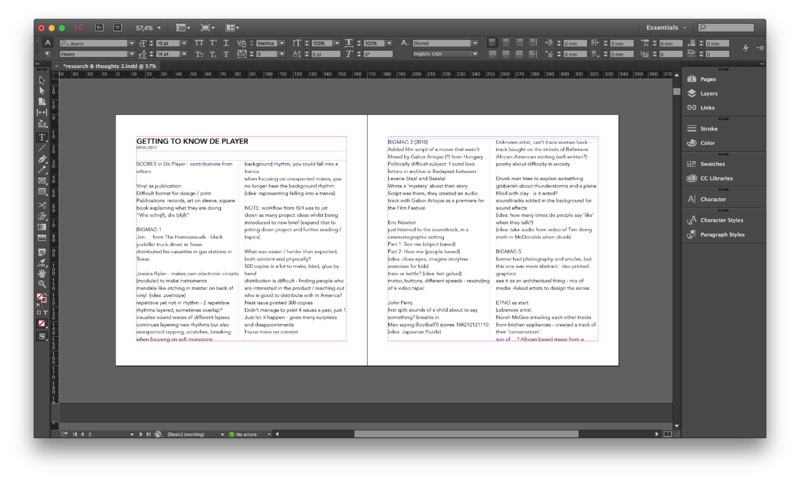
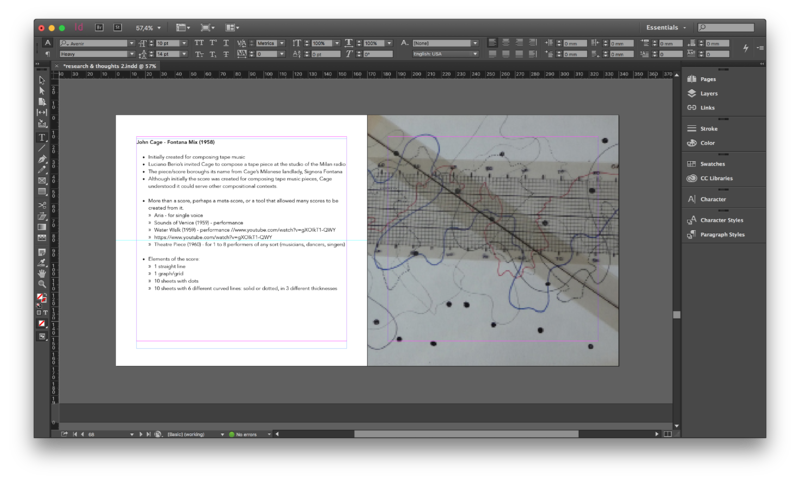
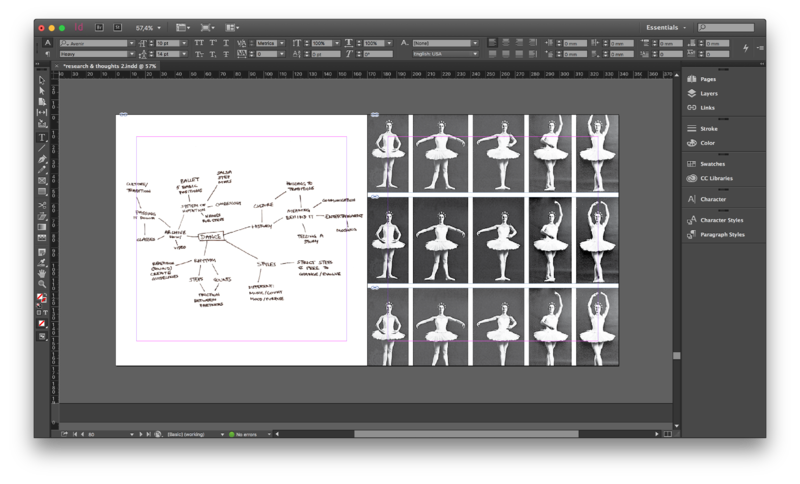
23 JANUARY
In my previous years I created nicely printed and bound 'sketchbooks' during any project. Any research would get printed, stored in a chronological order in a folder, and by the end of the project get bound into a book. I'd like to show the process of the score project this way too. The content would be:
- meeting notes
- pushing the score sessions
- experiments
- own thoughts / analysis
- own research and visuals
MID JANUARY?
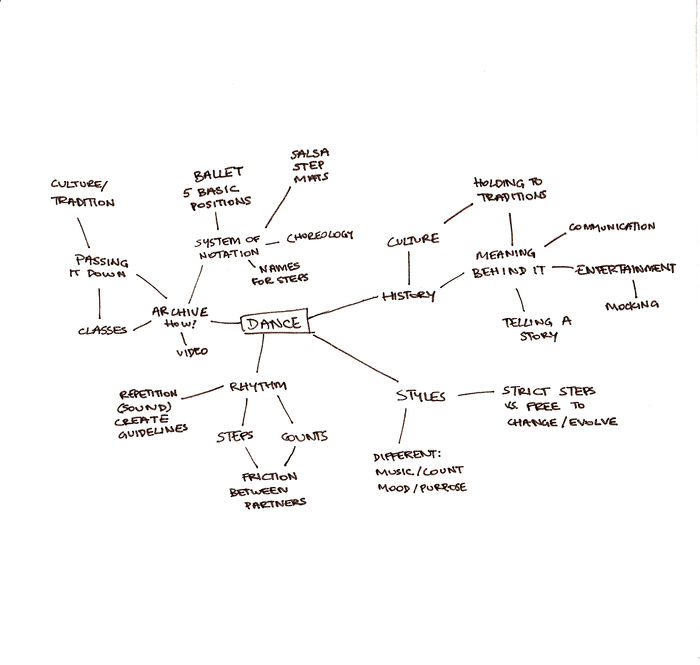
https://www.ted.com/talks/camille_a_brown_a_visual_history_of_social_dance_in_25_moves#t-264680
{{#ev:youtube | https://www.youtube.com/watch?v=OO6oPDwDzQs}}
Marian Wieczysty - Tańczyć może każdy (1986)
Slawomir Mrozek - Tango (1986)
http://www.e-teatr.pl/pl/programy/2013_12/56364/tango_teatr_mickiewicza_czestochowa_1986.pdf
CYMATICS: Science Vs. Music - Nigel Stanford
https://www.youtube.com/watch?v=Q3oItpVa9fs
10 JANUARY
Dance
- (idea: an occasion to nally lm all dance routines with Sean)
- Can we dance certain routines to different music styles / counts? Waltz at a 4 (not 3) count. Join Swing Basics / Charleston Green classes
- Read into notation systems for choreographers - what are they? will they be easy for me? can I read them without instructions?
- (idea: note down dance instructions. differentiate right / left foot by colour - right=blue, left=red)
- (idea: make rules to interpret score as a dance/choreography)
- (idea: let dice decide next move in jive. American Spin=2, Spanish Arms=3, Windmill=4)
- viewer could get involved by throwing dice, but performance cannot be archived / recreated
- (idea: how could it be connected to twister? - chance dedicates colour / movement)
- Some artist bought too many samples for the company to handle. This raises the question of whether the system needs upgrading. What questions does dance raise? Tango has storyline, Jive has African slave history (look into dance video)
- Look into history of different dances
- “The best way to predict the future is to invent it” - Alan Kay (1971)
- How could we predict the future using dance?
- Take possible news and correlate them to dice (chance) which is correlated to dance moves Take dance moves that are correlated to dice (chance) and correlate them with possible news
- Michiel Schuurman - new form of harmony using glitch
- Translating one type of content to another (python!) analog to digital
- Look into Alan Kay
Language
- Ask about artist (white record sleeve with black scattered letters on the wall) Find Letter from Santa
- Play around with Google Translate and speaking in different languages
- look into old project ideas: false auto correct in different languages?
9 JANUARY
Jessica Rylan
makes own electronic circuits (modular) to make instruments
mandala-like etching in master on back of vinyl (idea: zoetrope)
when focusing on unexpected noises, you no longer hear the background rhythm (idea: representing falling into a trance)
Eric Newton
(idea: close eyes, imagine storyline - exercises for kids)
train or kettle? (idea: het geluid)
John Perry
Man saying (football?) scores 104212121110 (idea: Japaanse Puzzle)
Unknown artist, can’t trace woman back
Drunk man tries to explain something gibberish about thunderstorms and a plane lled with clay - is it acted? soundtracks added in the background for sound effects
(idea: how many times do people say ‘like’ when they talk?)
(idea: take audio from video of Tim doing math in McDonalds when drunk)
Michael ...
recordings of Biranja language of Indian’s that travelled to Suriname to work (1988)
songs told stories of homeland but also about moral issues / life
Songs were later translated (text). This language was chosen because it is dying, due to migration / fusion with Surinamese (idea: how can language shape culture?) (idea: force google translate speak text from one language written phonetically in another - Message from Santa)
(idea: look into Polish language surviving thanks to sung / spoken prose / poetry - check artists that parents listened to) (idea: why / how does rhythm force us
to move? Gaudi’s work forced people to interact with it - staircase)
(idea: look into experience of Sri Lankan youth playing drums and singing in
train from Ella to Kandy. First traditional, later interacted with tourists and played commonly known melodies - Justin Bieber)
Records came in different sizes
3” records used for Spreekpoppen (speaking dolls from East Germany)
They could say ‘hello’ (idea: or they could sound demonic)
8” Transparent square record in perspex demonic sounds layered on drum rhythms and random sounds (Michael joked about Shazaming it)
(idea: everything is a remix. what if you shazam songs that play only music, without the lyrics that make it clear it’s a remix. How many versions can it nd? example of dad learning to use shazam)
Leif Lewin
sound reproduction
2 moulds and poured in liquid to create record
Image / etching of Jesus face is still carved in a spiral
Original Jesus face was carved in 1649 Track is the recording of touching the copper plate of the face
(idea: look into photo of female body covered with Brail)
Language and sounds William Burroughs look into DADA sound
look into white cover with scattered letters (on the wall)
(idea: Tim trying to speak Polish by glueing continents / sounds together

